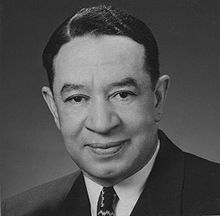J. Ernest Wilkins Sr.
American lawyer (1894–1959) From Wikipedia, the free encyclopedia
Jesse Ernest Wilkins Sr. (February 1, 1894 – January 19, 1959)[1] was a U.S. lawyer, labor leader, undersecretary in the Eisenhower administration and both the first African-American to be appointed to a sub-cabinet position in the United States Government and the first to attend White House cabinet-level meetings.[2][3]
J. Ernest Wilkins Sr. | |
|---|---|
 J. Ernest Wilkins Sr. U.S. Assistant Secretary of Labor, 1954–58 | |
| Born | February 1, 1894 |
| Died | January 19, 1959 (aged 64) |
| Resting place | Lincoln Cemetery |
| Alma mater | University of Illinois; University of Chicago |
| Known for | Labor leader, Undersecretary of Labor, Civil Rights |
| Political party | Republican |
| Spouse |
Lucille Robinson (m. 1922) |
| Children | 3 sons, including J. Ernest Wilkins Jr. |
After a falling-out with Secretary of Labor James P. Mitchell, Wilkins resigned from his sub-cabinet post in 1958, but continued to serve on the U.S. Civil Rights Commission.
Education and early career

Wilkins was the son of a Missouri Baptist preacher.[2] He studied mathematics at the University of Illinois and then attended the University of Chicago Law School in the 1920s. He was a member of its Phi Beta Kappa Society and then practiced law locally for several years.[4]
Public service
Summarize
Perspective
In 1954, Wilkins was appointed by President Dwight D. Eisenhower as Undersecretary of Labor for International Labor Affairs (UL-ILA),[2] thus becoming the first African-American to attend White House cabinet level meetings in the absence of his superior, Labor Secretary James Mitchell.[2][5] Wilkins had previously served the Eisenhower administration as acting chairman of the President's Committee on Government Contracts at the request of Val Washington.[6][7]
During his tenure with the administration he was a member of Equality Committee, working with E. Frederic Morrow, Val Washington, Joseph Douglas, James Nabrit Jr. and Samuel Pierce.[8] Still earlier he had been a member of Eisenhower's President's Committee on Governmental Employment Policy (PCGEP) board when he was with the Labor Department.[7]
In 1957, Labor Secretary Mitchell began working toward having Wilkins removed from his post, beginning by having Wilkins appointed to the U.S. Civil Rights Commission, where he became the first Black member.[9]
When Wilkins did not immediately resign, Mitchell applied pressure. He pushed back against a position paper that Wilkins proposed to deliver to the 1958 meeting of the U.N.'s International Labour Organization, then announced three days before the conference that Wilkins would be excluded from the meeting. Three days after the US delegation left for Geneva without him, Wilkins had a heart attack that hospitalized him for three months. Returning to work in July, 1958, he no longer had a full-time secretary.[9][10]
On August 5, 1958, Wilkins met with President Eisenhower to plead for his job, saying that he needed six more months to qualify for a civil service pension. (The Civil Rights Commission job was unpaid.) Eisenhower's response was that Mitchell was entitled to replace Wilkins. On November 6, 1958, Wilkins submitted his resignation and Mitchell named his replacement: George C. Lodge, the 35-year-old son of Henry Cabot Lodge.[10][11]
After resigning from his sub-cabinet post, Wilkins continued to serve on the Civil Rights Commission until his death two months later from another heart attack.[12][13][11]
While investigating charges that Black voting rights had been violated, his work with the six-member Civil Rights Commission was hampered in Montgomery, Alabama when he was refused accommodation at the hotel where the other commission members were staying. He subsequently found a room for himself at Maxwell Air Force Base.[14] When the commission tried to subpoena county voting records, they discovered that then-Circuit Judge George Wallace had seized the records, and was threatening to jail any commission member who would interfere in his jurisdiction.[14]
Other achievements
In 1953, Wilkins became the first African American to serve on the nine-member Judicial Council of the Methodist Church (which one, there are several, the United Methodist Church did not then exist and never has been the only one), when he was elected its secretary. The body is Methodism's nominal and administrative head.[15]
From 1954 to 1957, Wilkins served as U.S. representative on the governing body of the International Labour Organization.[3] In 1959, Wilkins also became the first African-American president of the Judicial Council of the Methodist Church.[3]
He also served as the Grand Polemarch (national president) of Kappa Alpha Psi fraternity.[2]
Personal life
Summarize
Perspective

Wilkins married Lucille Robinson (b. 1899 (?) - d. November 1964, Brooklyn, N.Y., aged 65), who taught school in Chicago, was secretary to the women's division of the Methodist Church, and who also practiced law with her husband for 33 years.[17]
Together they raised three sons: J. Ernest Wilkins Jr., who achieved fame as a mathematician and nuclear scientist; John Robinson Wilkins, who attended University of Wisconsin at the age of 14, Harvard Law School at 19, was elected to the Harvard Law Review, and went on to serve President Kennedy as general counsel for the Agency for International Development (AID);[4] and Julian B. Wilkins, who practiced general and corporate law.[17]
Wilkins died as a result of a heart attack in Washington, D.C., in late January 1959, at the age of 64.[3]
Wilkins is the grandfather of two notable attorneys: David B. Wilkins, a professor at the Harvard Law School, and Timothy A. Wilkins, a partner with Freshfields Bruckhaus Deringer.[18] In 2010 Wilkins' granddaughter, Carolyn Marie Wilkins, a Professor at the Berklee College of Music in Boston, wrote of her grandfather and her family more generally in her biography Damn Near White: An African American Family's Rise from Slavery to Bittersweet Success.[19]
See also
References
External links
Wikiwand - on
Seamless Wikipedia browsing. On steroids.
